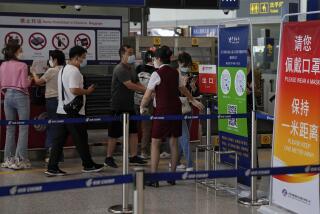South Korea and Japan spread welcome mat for Chinese tourists
- Share via
Reporting from Seoul — The young Chinese tourist stood amid the hustle and bustle of this city’s Myongdong shopping district and marveled. As a citizen of the globe’s most populous nation, with its ancient culture, she could shrug at the teeming crowds and jaw-dropping historic relics.
But she’d never seen anything like this.
“The skin care products,” whispered Li Wenqing. “They’re so cheap.”
In a region of longtime political rivalries and heavy diplomatic baggage, South Korea and Japan are making a move many critics say is based purely on economics.
The two nations are opening their doors, and cash registers, to China and its growing middle class.
Yielding to the prospect of millions of Chinese travelers with newfound buying power and an appetite for brand-name goods, South Korea and Japan in July eased visa restrictions for visitors from the staunchly communist country.
South Korea is hungry for tourism, and Japan’s economy remains sluggish, while China’s robust economic growth has allowed more of its people to consider foreign travel. Now both smaller Asian nations are competing for visitors from their colossal neighbor, whose influence they have long shunned.
“We’re the closest foreign country to China’s coast regions, considered a place where lots of rich Chinese live,” said Jin Jong-hwa, a senior official at the Korea Tourism Organization’s newly established China unit. “For them, South Korea is just an hour and a half away. With the new [visa] policies, now all they have to do is buy a flight ticket and visit whenever they want.”
Not to be outdone, Japanese officials say they have what Chinese tourists want: luxury electronic items.
“They demand high-quality electronics,” said Koichi Ueno, an official in the international unit of the government-run Japan Tourism Agency. “South Korea has good quality, but Japan’s is much better.”
Under South Korea’s new rules, teachers, retirees and graduates of prestigious universities can get multiple-entry visas good for one year. Previously, most Chinese visitors were required to travel in cumbersome tour groups.
In Japan, officials will now issue tourist visas to Chinese who earn more than $8,800 annually, a sharp drop from the previous requirement of $37,000 a year.
Recently, the number of Chinese visitors to both nations has soared. Chinese accounted for nearly 1 in 5 of the tourists in Japan during the first six months of this year. The number of Chinese visitors rose to 1.1 million last year from 350,000 a decade ago, Japanese officials said.
In South Korea, the number of Chinese tourists climbed to 1.2 million in 2009 from 586,000 in 2005. Chinese are also the biggest spenders, shelling out $2,203 per trip, a rate 32% higher than the average, Korean officials say.
The new rules will help Chinese nationals working for Korean-owned companies to visit, say officials, who are also discussing a new medical visa system to attract wealthy Chinese patients to high-tech hospitals in Seoul.
South Korea has also created a separate trade-promotion division to increase Chinese investment. Holding the world’s largest foreign reserves at nearly $2.5 trillion, China invested $56 billion abroad in 2008, but only $100 million in South Korea, officials here say.
However, many observers acknowledge that more Chinese visitors bring the risk of illegal immigration and crime.
“Everything has upsides and downsides,” said Suh Jin-young, a political science professor at Korea University. “But this measure can help develop the economy in Northeast Asia and contribute to making this region one community.”
The Japanese government has also been criticized for its moves to attract Chinese visitors.
“Some Japanese believe Chinese are not good-quality tourists; [they] might try to outstay their welcome,” said Ueno of the Japan Tourism Agency. “We believe most Chinese have good lives and will want to go home.”
But not before making some killer deals on consumer purchases. Skin care enthusiast Li wandered through Myongdong, passing cosmetics stores with names such as Skin Food, Laneige and Baviphat. “Everything is 30% cheaper than back home,” the 26-year-old said.
A few feet away, tourist Mike Li of Shanghai said he wasn’t in South Korea to shop. “I just like to get out of China once in a while and see what’s new,” the 30-year-old computer worker said.
So far, he said, his first trip to Seoul was nothing to write home about.
“It’s not Shanghai,” he said.
Ju-min Park at The Times’ Seoul Bureau contributed to this report.
More to Read
Sign up for The Wild
We’ll help you find the best places to hike, bike and run, as well as the perfect silent spots for meditation and yoga.
You may occasionally receive promotional content from the Los Angeles Times.







